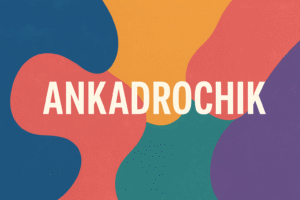
What is Ankadrochik?
The term “ankadrochik” denotes a unique cultural artifact that has garnered significant attention across various disciplines. Its origins can be traced back to specific regions where it was crafted using traditional methods. The ankadrochik serves multiple functions, often embodying both utilitarian and decorative aspects, which highlight its multifaceted nature. Crafted from a variety of materials—in most cases, local resources—the ankadrochik showcases the creativity and artistry of the cultures producing it.
Historically, the ankadrochik has played a pivotal role in community rituals and social gatherings. Its presence was not merely for aesthetics; it often held deeper meanings related to identity and heritage. The evolution of the ankadrochik over time reflects the shifting values and practices of those who create and use it. As societies evolve, the ankadrochik adapts, embodying contemporary influences while retaining its traditional roots.
One of the key characteristics that distinguish ankadrochik from similar items is its intricate designs and the symbolism embedded within them. These elements serve as a narrative device, communicating the stories and beliefs of the culture from which they originate. Moreover, each ankadrochik piece can vary widely in form and function, allowing for a diverse range of expressions among different artisans. This characteristic sets ankadrochik apart, as it is not just a static object but a dynamic representation of cultural identity. With the increasing globalization, the ankadrochik has garnered international interest, becoming a significant subject of study in fields like anthropology, art history, and cultural studies. Understanding the ankadrochik thus provides essential insights into the ways culture, identity, and artistry intertwine throughout history.
The Unique Features of Ankadrochik
The ankadrochik stands out in the realm of design and craftsmanship, characterized by an array of distinctive traits that contribute to its allure and widespread appeal. One defining aspect of the ankadrochik is its intricate craftsmanship, which often showcases the meticulous skills of artisans dedicated to producing high-quality pieces. The attention to detail involved in creating each ankadrochik ensures that it is not just a mere ornament, but rather a manifestation of cultural significance and artistic expression.
Materials used in the construction of an ankadrochik vary widely, ranging from traditional elements such as wood and metal to contemporary materials that enhance both durability and aesthetic appeal. Many artisans opt to incorporate natural finishes that revitalize the beauty of the raw materials, giving each piece a unique character. The thoughtful selection of these materials not only enhances the ankadrochik’s visual impact but also serves to bridge the gap between functionality and art.
The aesthetic appeal of the ankadrochik is undeniable. Its design often reflects a harmonious blend of traditional motifs and modern elegance, making it versatile enough to complement a myriad of decor styles. From minimalist spaces to more ornate settings, the ankadrochik can serve as both a focal point and a subtle accent, thus resonating with diverse audiences. Furthermore, its functionality is equally impressive; many ankadrochiks are designed to offer practical uses while maintaining their decorative charm, which adds to their versatility in everyday life.
Ultimately, the unique features of the ankadrochik—its craftsmanship, material selection, aesthetic allure, and functional design—together create an appealing package that captivates the interest of many. Such characteristics not only enhance the item’s popularity but also ensure its place in various cultural contexts and settings.

Cultural Impact and Symbolism of Ankadrochik
The ankadrochik is not merely an object; it embodies a rich tapestry of cultural significance and symbolism across various societies. Historically, the ankadrochik has served as a conduit for artistic expression, influencing both traditional and contemporary art forms. In many cultures, it is viewed as a representation of connection—linking communities to their heritage, beliefs, and the natural world. For instance, in certain Indigenous cultures, the ankadrochik symbolizes the unity of life and the interconnectedness of all beings. This perspective fosters a deep respect for nature and the sustaining resources it provides.
In various rituals and ceremonies, the ankadrochik assumes a pivotal role, serving not only as a decorative item but also as a powerful symbol of protection and spirituality. For example, some African tribes incorporate ankadrochik in their rites of passage, viewing it as a guardian of the individual’s transition into a new phase of life. This practice underscores the ankadrochik’s function as a bridge between the physical and spiritual realms, enhancing its cultural relevance.
Moreover, the interpretation of ankadrochik varies significantly across different regions. In Eastern cultures, it is often associated with prosperity and fortune, while in Western artistic representations, it may be depicted as a symbol of resilience and strength. These diverse meanings contribute to the ankadrochik’s durability as a cultural artifact, as communities continuously reinterpret it through their unique lenses. Ultimately, exploring the cultural impact and symbolism of the ankadrochik reveals its deeper themes of identity, continuity, and community. It is clear that this object transcends its physical form, emerging as an essential element that enriches cultural narratives around the world.
How to Incorporate Ankadrochik into Your Life
Integrating ankadrochik into your daily routine can enhance not only your personal style but also your living environment. To begin with, selecting the right ankadrochik is crucial. Consider your personal aesthetic and the purpose you wish it to serve—whether for functionality, decoration, or as a conversation piece. Visit local shops or online platforms that specialize in ankadrochik to explore diverse materials, colors, and designs, ensuring the piece harmonizes with your existing collection.
When it comes to styling, ankadrochik can be quite versatile. In fashion, for instance, ankadrochik can serve as a distinctive accessory, easily paired with both casual and formal wear. Match your ankadrochik against contrast colors to make a statement or opt for complementary shades for a more understated look. In home décor, consider displaying ankadrochik on shelves, mantlepieces, or tables, where its unique characteristics can draw attention without overwhelming other decor elements. Proper placement can elevate your overall aesthetic while inviting admiration from visitors.
Caring for your ankadrochik is essential to maintain its appeal. Depending on the material, ensure you follow best practices for cleaning and storage. Some ankadrochik may require gentle handling, while others can withstand everyday use. Establishing a regular cleaning schedule will not only keep the item looking new but also extend its lifespan, affirming its value in your collection.
Lastly, ankadrochik makes for a thoughtful gift. When selecting it as a gift, consider the recipient’s tastes and interests. A well-chosen ankadrochik can represent a meaningful sentiment, turning into a cherished keepsake. By fostering an appreciation for ankadrochik, you help others recognize its unique charm and multifaceted role in both personal style and home ambiance.
What is Ankadrochik?
The term “ankadrochik” denotes a unique cultural artifact that has garnered significant attention across various disciplines. Its origins can be traced back to specific regions where it was crafted using traditional methods. The ankadrochik serves multiple functions, often embodying both utilitarian and decorative aspects, which highlight its multifaceted nature. Crafted from a variety of materials—in most cases, local resources—the ankadrochik showcases the creativity and artistry of the cultures producing it.
Historically, the ankadrochik has played a pivotal role in community rituals and social gatherings. Its presence was not merely for aesthetics; it often held deeper meanings related to identity and heritage. The evolution of the ankadrochik over time reflects the shifting values and practices of those who create and use it. As societies evolve, the ankadrochik adapts, embodying contemporary influences while retaining its traditional roots.
One of the key characteristics that distinguish ankadrochik from similar items is its intricate designs and the symbolism embedded within them. These elements serve as a narrative device, communicating the stories and beliefs of the culture from which they originate. Moreover, each ankadrochik piece can vary widely in form and function, allowing for a diverse range of expressions among different artisans. This characteristic sets ankadrochik apart, as it is not just a static object but a dynamic representation of cultural identity. With the increasing globalization, the ankadrochik has garnered international interest, becoming a significant subject of study in fields like anthropology, art history, and cultural studies. Understanding the ankadrochik thus provides essential insights into the ways culture, identity, and artistry intertwine throughout history.
The Unique Features of Ankadrochik
The ankadrochik stands out in the realm of design and craftsmanship, characterized by an array of distinctive traits that contribute to its allure and widespread appeal. One defining aspect of the ankadrochik is its intricate craftsmanship, which often showcases the meticulous skills of artisans dedicated to producing high-quality pieces. The attention to detail involved in creating each ankadrochik ensures that it is not just a mere ornament, but rather a manifestation of cultural significance and artistic expression.
Materials used in the construction of an ankadrochik vary widely, ranging from traditional elements such as wood and metal to contemporary materials that enhance both durability and aesthetic appeal. Many artisans opt to incorporate natural finishes that revitalize the beauty of the raw materials, giving each piece a unique character. The thoughtful selection of these materials not only enhances the ankadrochik’s visual impact but also serves to bridge the gap between functionality and art.
The aesthetic appeal of the ankadrochik is undeniable. Its design often reflects a harmonious blend of traditional motifs and modern elegance, making it versatile enough to complement a myriad of decor styles. From minimalist spaces to more ornate settings, the ankadrochik can serve as both a focal point and a subtle accent, thus resonating with diverse audiences. Furthermore, its functionality is equally impressive; many ankadrochiks are designed to offer practical uses while maintaining their decorative charm, which adds to their versatility in everyday life.
Ultimately, the unique features of the ankadrochik—its craftsmanship, material selection, aesthetic allure, and functional design—together create an appealing package that captivates the interest of many. Such characteristics not only enhance the item’s popularity but also ensure its place in various cultural contexts and settings.
Cultural Impact and Symbolism of Ankadrochik
The ankadrochik is not merely an object; it embodies a rich tapestry of cultural significance and symbolism across various societies. Historically, the ankadrochik has served as a conduit for artistic expression, influencing both traditional and contemporary art forms. In many cultures, it is viewed as a representation of connection—linking communities to their heritage, beliefs, and the natural world. For instance, in certain Indigenous cultures, the ankadrochik symbolizes the unity of life and the interconnectedness of all beings. This perspective fosters a deep respect for nature and the sustaining resources it provides.
In various rituals and ceremonies, the ankadrochik assumes a pivotal role, serving not only as a decorative item but also as a powerful symbol of protection and spirituality. For example, some African tribes incorporate ankadrochik in their rites of passage, viewing it as a guardian of the individual’s transition into a new phase of life. This practice underscores the ankadrochik’s function as a bridge between the physical and spiritual realms, enhancing its cultural relevance.
Moreover, the interpretation of ankadrochik varies significantly across different regions. In Eastern cultures, it is often associated with prosperity and fortune, while in Western artistic representations, it may be depicted as a symbol of resilience and strength. These diverse meanings contribute to the ankadrochik’s durability as a cultural artifact, as communities continuously reinterpret it through their unique lenses. Ultimately, exploring the cultural impact and symbolism of the ankadrochik reveals its deeper themes of identity, continuity, and community. It is clear that this object transcends its physical form, emerging as an essential element that enriches cultural narratives around the world.
How to Incorporate Ankadrochik into Your Life
Integrating ankadrochik into your daily routine can enhance not only your personal style but also your living environment. To begin with, selecting the right ankadrochik is crucial. Consider your personal aesthetic and the purpose you wish it to serve—whether for functionality, decoration, or as a conversation piece. Visit local shops or online platforms that specialize in ankadrochik to explore diverse materials, colors, and designs, ensuring the piece harmonizes with your existing collection.
When it comes to styling, ankadrochik can be quite versatile. In fashion, for instance, ankadrochik can serve as a distinctive accessory, easily paired with both casual and formal wear. Match your ankadrochik against contrast colors to make a statement or opt for complementary shades for a more understated look. In home décor, consider displaying ankadrochik on shelves, mantlepieces, or tables, where its unique characteristics can draw attention without overwhelming other decor elements. Proper placement can elevate your overall aesthetic while inviting admiration from visitors.
Caring for your ankadrochik is essential to maintain its appeal. Depending on the material, ensure you follow best practices for cleaning and storage. Some ankadrochik may require gentle handling, while others can withstand everyday use. Establishing a regular cleaning schedule will not only keep the item looking new but also extend its lifespan, affirming its value in your collection.
Lastly, ankadrochik makes for a thoughtful gift. When selecting it as a gift, consider the recipient’s tastes and interests. A well-chosen ankadrochik can represent a meaningful sentiment, turning into a cherished keepsake. By fostering an appreciation for ankadrochik, you help others recognize its unique charm and multifaceted role in both personal style and home ambiance.


